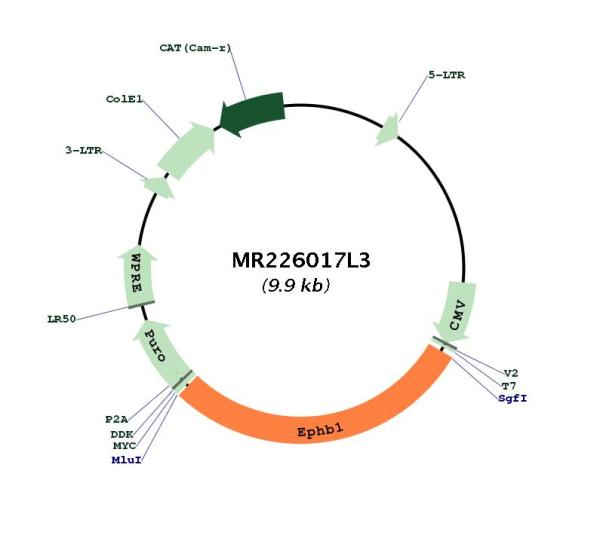Ephb1 (NM_001168296) Mouse Tagged Lenti ORF Clone
CAT#: MR226017L3
- LentiORF®
Lenti ORF clone of Ephb1 (Myc-DDK-tagged) - Mouse Eph receptor B1 (Ephb1), transcript variant 2
"NM_001168296" in other vectors (4)
Interest in protein/lysate? Submit request here!
Specifications
| Product Data | |
| Type | Mouse Tagged ORF Clone |
| Tag | Myc-DDK |
| Symbol | Ephb1 |
| Synonyms | 9330129L11; AW488255; C130099E04Rik; Cek6; Elk; Elkh; ENSMUSG00000074119; Hek6; Net |
| Vector | pLenti-C-Myc-DDK-P2A-Puro |
| E. coli Selection | Chloramphenicol (34 ug/mL) |
| Mammalian Cell Selection | Puromycin |
| Sequence Data |
The ORF insert of this clone is exactly the same as(MR226017).
|
| Restriction Sites |
SgfI-MluI
Cloning Scheme for this gene
Plasmid Map

|
| ACCN | NM_001168296 |
| ORF Size | 2829 bp |
| OTI Disclaimer | The molecular sequence of this clone aligns with the gene accession number as a point of reference only. However, individual transcript sequences of the same gene can differ through naturally occurring variations (e.g. polymorphisms), each with its own valid existence. This clone is substantially in agreement with the reference, but a complete review of all prevailing variants is recommended prior to use. More info |
| OTI Annotation | This clone was engineered to express the complete ORF with an expression tag. Expression varies depending on the nature of the gene. |
| Product Components | The ORF clone is ion-exchange column purified and shipped in a 2D barcoded Matrix tube containing 10ug of transfection-ready, dried plasmid DNA (reconstitute with 100 ul of water). |
| Reconstitution | 1. Centrifuge at 5,000xg for 5min. 2. Carefully open the tube and add 100ul of sterile water to dissolve the DNA. 3. Close the tube and incubate for 10 minutes at room temperature. 4. Briefly vortex the tube and then do a quick spin (less than 5000xg) to concentrate the liquid at the bottom. 5. Store the suspended plasmid at -20°C. The DNA is stable for at least one year from date of shipping when stored at -20°C. |
| Reference Data | |
| RefSeq | NM_001168296.1, NP_001161768.1 |
| RefSeq Size | 4563 bp |
| RefSeq ORF | 2832 bp |
| Locus ID | 270190 |
| UniProt ID | Q8CBF3 |
| Cytogenetics | 9 F1 |
| Gene Summary | Receptor tyrosine kinase which binds promiscuously transmembrane ephrin-B family ligands residing on adjacent cells, leading to contact-dependent bidirectional signaling into neighboring cells. The signaling pathway downstream of the receptor is referred to as forward signaling while the signaling pathway downstream of the ephrin ligand is referred to as reverse signaling. Cognate/functional ephrin ligands for this receptor include EFNB1, EFNB2 and EFNB3. During nervous system development, regulates retinal axon guidance redirecting ipsilaterally ventrotemporal retinal ganglion cells axons at the optic chiasm midline. This probably requires repulsive interaction with EFNB2. In the adult nervous system together with EFNB3, regulates chemotaxis, proliferation and polarity of the hippocampus neural progenitors. In addition to its role in axon guidance plays also an important redundant role with other ephrin-B receptors in development and maturation of dendritic spines and synapse formation. May also regulate angiogenesis. More generally, may play a role in targeted cell migration and adhesion. Upon activation by EFNB1 and probably other ephrin-B ligands activates the MAPK/ERK and the JNK signaling cascades to regulate cell migration and adhesion respectively. Involved in the maintenance of the pool of satellite cells (muscle stem cells) by promoting their self-renewal and reducing their activation and differentiation (PubMed:27446912).[UniProtKB/Swiss-Prot Function] |
Documents
| Product Manuals |
| FAQs |
| SDS |
Resources
Other Versions
| SKU | Description | Size | Price |
|---|---|---|---|
| MC222760 | Ephb1 (untagged) - Mouse Eph receptor B1 (Ephb1), transcript variant 2, (10ug) |
USD 951.00 |
|
| MG226017 | Ephb1 (tGFP-tagged) - Mouse Eph receptor B1 (Ephb1) transcript variant 2, (10ug) |
USD 1,063.00 |
|
| MR226017 | Ephb1 (Myc-DDK-tagged) - Mouse Eph receptor B1 (Ephb1), transcript variant 2 |
USD 863.00 |
|
| MR226017L4 | Lenti ORF clone of Ephb1 (mGFP-tagged) - Mouse Eph receptor B1 (Ephb1), transcript variant 2 |
USD 1,163.00 |
{0} Product Review(s)
Be the first one to submit a review






























































































































































































































































 Germany
Germany
 Japan
Japan
 United Kingdom
United Kingdom
 China
China


